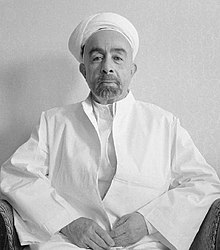Abdullah I of Jordan
Appearance
| Abdullah I | |
|---|---|
 | |
| King of Jordan | |
| Reign | 25 May 1946 – 20 July 1951 |
| Predecessor | Himself as Emir of Transjordan |
| Successor | Talal |
| Emir of Transjordan | |
| Reign | 11 April 1921 – 25 May 1946[1][2] |
| Predecessor | Office Established |
| Successor | Himself as King |
| Born | 2 February 1882 Mecca, Ottoman Empire |
| Died | 20 July 1951 (aged 69)[3][4] Jerusalem |
| Burial | |
| Consort | |
| Junior wives |
Nahda bint Uman (m. 1949) |
| Issue | Princess Haya Talal I Prince Naif Princess Munira Princess Maqbula Princess Naifeh |
| House | Hashemite |
| Father | Hussein bin Ali |
| Mother | Abdiyya bint Abdullah |
| Religion | Sunni Islam |
Abdullah I bin Al-Hussein (Arabic: عبد الله الأول بن الحسين, Abd Allāh Al-Awal ibn Al-Husayn, 2 February 1882 – 20 July 1951) was the ruler of Jordan and Transjordan, from 1921 until his assassination in 1951. He was Jordan's first King.
During World War I, he played a key role in secret negotiations with the United Kingdom. This led to the Great Arab Revolt against Ottoman rule that was led by his father Sharif Hussein.[5] Abdullah led guerrilla raids on Ottoman garrisons.[6]
Abdullah was shot and killed in Jerusalem by a Palestinian activist on 20 July 1951, aged 69.
References
[change | change source]- ↑ Kamal S. Salibi (15 December 1998). The Modern History of Jordan. I.B.Tauris. p. 93. ISBN 978-1-86064-331-6.
- ↑ Hashemite Monarchs of Jordan, "The Emirate of Transjordan was founded on April 11, 1921, and became the Hashemite Kingdom of Jordan upon formal independence from Britain in 1946"
- ↑ Hoiberg, Dale H., ed. (2010). "Abdullah". Encyclopædia Britannica. Vol. I: A-ak Bayes (15th ed.). Chicago, Illinois: Encyclopædia Britannica Inc. p. 22. ISBN 978-1-59339-837-8.
- ↑ Some sources state that his birth date was on 22 September.
- ↑ Encyclopaedia Britannica (online). Abdullah I:...
- ↑ Shlaim (2007), p. 3
